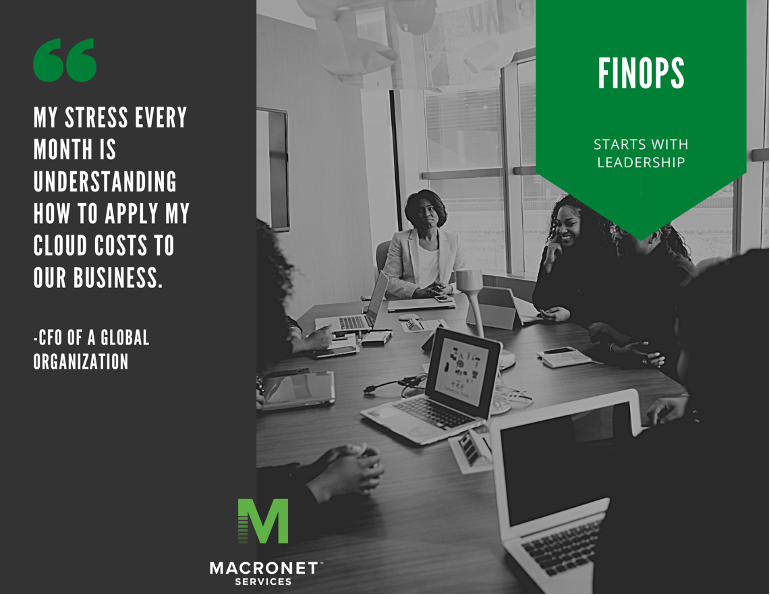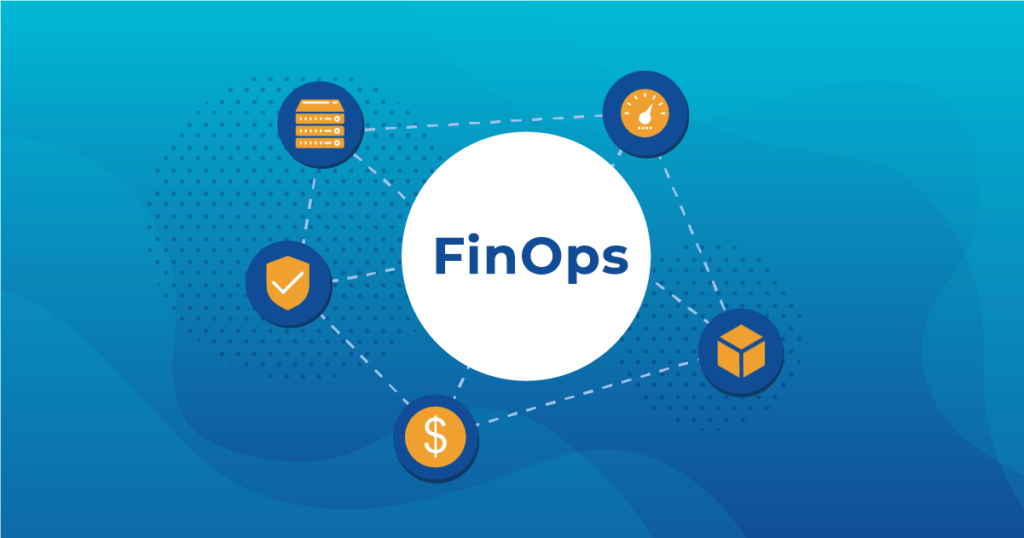What is FinOps? The Easy Explanation
FinOps is about building a culture focused on financial accountability across cloud services within an organization. It does not necessarily mean reducing spend but rather a balance of growth, iteration and real-time reporting communicating your utilization of cloud services (and why) in your business. This effective workflow builds complete responsibility and common set of goals across development, engineering, operations, product, sales, marketing and finance teams. Enabling the organization to fully understand the push and pull cloud optimization can help drive a successful business as it is working for countless organizations today. Macronet advises organizations of all levels across their FinOps journey and desired outcomes.
Moving to the cloud was originally touted as the main driver for cost savings however several years later in the industry, this simply isn’t true. Scaling, product innovation and proximity to end users are larger drivers for cloud adoption vs. cost savings. In fact, it might be more expensive for you business to adopt a cloud-first strategy however that might propel you past competition, speed to delivery and cross-sell/upsell of existing customer. Queue the Customer Success Organization!
Many organizations struggle with the following on cloud services for their growth and products for customers:
- Dev/Ops/Engineering are not fully aware of the opex associated with their workloads during growth or pay close attention during “spiked” utilization periods. They realize peaks and valleys of utilization however most are not viewing costs daily. As a result, teams see Finance as a roadblock who can’t fully comprehend their technical development needs to scale the organization especially if they are breathing down their back on the cloud bill.
- Finance is generally not technical and the shift from amortization of traditional hardware and software licenses over a fixed 3-year period is gone. They must transform from the fixed capex model in the datacenter and adjust the procurement process as it’s now in the hands of ops. Understanding daily costs within cloud and how to budget and forecast with cloud is a challenge for most finance organizations here which is understandable. However, someone has to explain to them why an app-tier and db tier might reside in two different IaaS environments for example
The Purple Unicorn does not usually exist. This is the person or group who has deep financial experience and complete technical aptitude around cloud. In full disclosure, most organizations do not realize they need the purple unicorn either and ultimately continue to disagree between tech and finance teams. If this is your organization, you are not alone.
Operationally, both sides Tech and Finance are two ships passing in the night missing the opportunity to change the outcome and leverage a cloud product and cost aware culture. This is normal, and the fix is simply to build a FinOps practice, the challenge however is where to start to support your organization’s use case.
How to create a FinOps Team:
While it sounds good on paper, bringing both cloud operations and finance organizations together for a centralized focus on infrastructure, in practice is much different compared to anything delivered in the past. Building a team is one part who is singularly focused on the cloud tech, health, reporting and financial understanding of anything as a service. However, the first step is ultimately a cultural mindset which should be across everyone in the organization, starting with leadership. Let’s cover with the basics
- Executive Approval: The decision from the C-level in the organization must agree, even if it’s in practice to start a centralized FinOps practitioner team. This should not be seen as movement to punish anyone, rather leverage a team in the middle to secure areas such as savings plans and rates which all in the cloud workstream can take advantage of. We’ll cover further definitions of this central team but without everyone believing in FinOps from the leadership level, it will be challenging to win the hearts and minds of dev and finance.
- Cloud Experience: Ultimately your practioners must have some cloud experience. Their ability to articulate the inner workings of how instances are deployed, managed and accounted for into terms Finance can start to understand is the first step. Finance generally does not understand how Kubernetes works or why it’s deployed or how the Spot market with AWS can support upwards of 90% saving cost in EC2 for short periods (once they understand Spot, invariably the first question they ask is “How can we use Spot all of the time for lowered costs???!!!!” )
- Impartial Information: If they are reporting out on a daily or worst-case weekly basis of cost over runs, this team must expect the engineering organization to execute the changes. Removing the budget and cloud cost allocation away from any one development team, placing it within FinOps will ensure there are no concerns of hidden agendas.
 |
Cloud “Accountability” is a must to have a successful FinOps practice. Knowing that many tech teams are not jazzed about costs and financial terms and Finance teams equally do not understand cloud tech levels the playing field.
“Over 50% over the organizations Macronet Services polled did not even know what FinOps was. The result is there is a huge opportunity to optimize and iterate!” |
Who is involved in FinOps?
- Management: Often the leads of Product, Engineering or CIO/CTO for larger enterprise organizations. In smaller, cloud native companies, this could move closer to the CEO and each leader might have a player/coach role in their cloud dev and product fulfillment thus an even more reason to have a central FinOps practitioner team.
- FinOps Job Titles: Titles can vary however in the end it really comes down to who is serving as the practioners between tech and finance to support your org. Many folks should be involved and may look like Cloud Operations, Cloud Cost Optimization Manager, FinOps Analyst and Cloud Operations Manager.
- Dev/Engineering: They are the creators of the platform you deliver to customers using public cloud for example. These highly skilled individuals need to be aware of their good work and how it impacts the bottom line. Providing these teams, a cost KPI/Metric in the same workflow fashion they would receive on performance/IOPS etc. is critical. If Finance truly feels this group does not understand costs associated with their workloads and nobody points it out daily, well, they are right. If you want cost control and awareness but do not provide the numbers (regardless if there is an overrun) how can you expect it to change? Engineering will be the team to rightsize the platform, so you need to provide an output they can relate to, iterate and adjust.
- Finance Department: They take the reporting from the FinOps organization to build their modeling, accurately forecasting the cloud contribution to the business. However, if the cloud ops team constantly speaks past them with jargon (take the propeller hat off) and does not break it down, they will be lost. In fact, many organizations have the same definition just a different term associated with various components in cloud. So, one easy knockdown win is to decide holistically as a company, common terms for your business vs. those a vendor would prefer. This might be a Marketing Manager’s worst nightmare not using the cool terms for their platform you are renting hourly but in the end the goal is to speak the same language, not having an interpreter.
Where does the FinOps report to in the employee Hierarchy?
Typically Report to:
Many companies place the FinOps team under the C-level, usually the CTO or CIO who is responsible for the overall technical organization and deployment of cloud. Some would argue this does not keep things completely impartial as this group is the one who spends the most in cloud…. can you blame finance if they scratch their head here? This does not mean it’s the absolute worst thing, especially if you are a scrappy startup, just know as you mature, placing it outside this group might prove more beneficial, here’s why.
Recommendations:
Successful FinOps teams and practitioners will achieve greater credibility to the engineering teams receiving recommendations by the FinOps team.
There is a level of “street cred” associated with a group who understands the infrastructure tech and is not 100% finance focused. Macronet typically recommends a FinOps teams is placed under the COO or CEO hierarchy with matrix reporting both into Finance and the CTO/Engineering Office.
This allows both Tech and Finance the ability to have visibility and impartial focus while the team serves out from the COO and CEO’s vision independently. There is no reason why your Chief People Officer/HR leadership would be opposed to a matrix reporting hierarchy as it will build cross-pollinization at the individual contributor level while unit leaders (Cloud & Finance) feel they have a level of autonomy to set objectives for this group.
When should you implement a FinOps practice?
The number one question asked is when should “we” as an organization launch a FinOps team to support our business objectives? Often, companies are at cross-roads and fall into two categories for a decision:
- Cloud Spend is out of Control
This is when many organizations pause and look to pull the alarm as they realize there is no cloud cost optimization, hourly costs are out of control, or they can’t quantify if their investment scaling the company. (Is the amount we are spending truly helping us grow or are we atrophying and ultimately losing?)
- Experience in Cloud – not your first Rodeo!
How many times have we sat and thought, if I could go back in time, I sure would have made a different decision or done something better? This is almost always they case as we become wiser especially in business and certainly applicable in the multi-cloud options today. Executives, Engineers, Ops and even Finance teams have realized public cloud is not a one-size fits all. Not only are teams who have lived and learned from the positives/negatives in cloud have taken this experience to FinOps.
Even if organizations have not adopted a FinOps practice yet, it’s clear experience and the “second chance” to go back and re-work a cloud strategy pays off. A good example case is where Gadget Software, an existing AWS customer opted to make changes in their environment moving to Oracle Cloud Infrastructure. This afforded them speed and agility to deploy their apps for customers while reducing costs.
Culture & Teamwork Shift
Teams that take on the challenge of working together will outpace their competitors. Again, going all in day 1 with a FinOps mindset is great but if it is in fact your first rodeo, understand you will have to slowly pace yourself. Key components to be mindful of:
- Business Value of Cloud Drives Business Decisions:
- Evaluation of trade-offs across cost, quality and speed to deployment. It will happen when you must incur a higher cost perhaps in your compute consumption in order to maintain a steady stream of customer needs. In the old world of colocation, you’d have to pray you purchased enough server power but not too much it would sit idle. This is where regular/daily output of performance, compute usage, costs and a proper feedback loop for all is critical.
- Cloud must be thought of as a driver of innovation not just a line item of expense. If your sales SKUs are SaaS or some sort of offering built on Cloud, the mindset can’t be to align the costs similar to the electric bills at the office. You can turn off the electricity at the office and employees can work from home. Turn-down of your cloud tenancy where the entire business plan is connected to would cease your operations.
- Accountability: Dev/Ops teams must take accountabilities for all priorities in the business, not just their sprint or group focus. Otherwise, finance will have a difficult time budgeting, forecasting or allocation of cloud spend to the business. Conversely, providing a tight, cost approval process first before innovation spend can occur (think of asking permission before you add consumption) would stifle innovation and agility speed would falter. This is an easy target for your competitors to exploit.

FinOps outside of traditional Public Cloud Services
The practice of FinOps has been touted as a lifesaver for many companies due to the cultural change of total cost accountability, iterating change and scaling together. However, many organizations indirectly have forgotten other services such as voice and network services to be included within FinOps. Areas to include outside of traditional SaaS and IaaS service which will expand the technical reach requirement for your practioners:
- FinOps for Unified Communications as a Service (UCaaS) – Covid drove many companies to re-think their voice architecture, ditching their legacy PBX in favor of cloud voice services and video collaboration.
Advantage: Cloud Voice services when negotiated correctly and implemented timely (porting existing numbers) can dramatically improve scale, communication and cost savings.
Disadvantage: If proper license management and reporting feature reviews (does every user require eFax, Contact Center licensing etc.) are not added programmatically to the internal FinOps workflow, cost creep is inevitable.
- Software Defined WAN & CSP Connectivity – Wide Area Networks will continue to evolved and in many case narrow to route toward public cloud. More employees are working from home, thus less reliance on corporate networks to the office. As this change occurs, organizations should look at their traditional telecom deployment as some have developed into a paygo service.
Advantage: Architecting & deploying Cloud Networks are an easy win for FinOps teams across Dev and Finance. Many cloud teams are not deep experts in routing and switching with carriers, nor should they be. However, there are hundreds of offerings (literally) to connect into AWS, Azure, OCI, IBM, SalesForce etc.
Disadvantage: Not having the deep experience in WAN routing can quickly implement latency into your cloud tenancy and costs. Many providers offer higher costs, longer terms vs. an equal offering cheaper, faster and minimal or no terms at all. This again requires the FinOps team to truly comprehend the software-defined network market and possibly educate finance and cloud ops a bit as well.
Are you ready to discuss how building a FinOps mindset in your organization will help you scale & support your customers? Please contact us, we would love to talk about how the first step can help your organization propel to the next level in a cost-aware culture. èContact the Macronet Services team to discuss further
Tags In
Related Posts
1 Comment
Comments are closed.
Recent Posts
- How Laser Satellite Communication Breakthroughs Compete with Starlink
- AI-Powered Humanoid Robots: Transforming Business, Homes & Connectivity
- Top IT & Network Design Consultants in Boston and New England: Macronet Services
- Top AI Consultants in New England: Why New Hampshire’s Macronet Services Shines in Boston and Beyond
- IXPs in the US and Internet Peering
Archives
- July 2025
- June 2025
- May 2025
- April 2025
- March 2025
- February 2025
- January 2025
- December 2024
- November 2024
- October 2024
- September 2024
- August 2024
- July 2024
- June 2024
- May 2024
- April 2024
- March 2024
- February 2024
- January 2024
- December 2023
- November 2023
- October 2023
- September 2023
- August 2023
- July 2023
- June 2023
- May 2023
- April 2023
- March 2023
- February 2023
- January 2023
- December 2022
- November 2022
- October 2022
- September 2022
- August 2022
- July 2022
- June 2022
- May 2022
- April 2022
- March 2022
- February 2022
- January 2022
- December 2021
- November 2021
- October 2021
- September 2021
- August 2021
- July 2021
- June 2021
- May 2021
- April 2021
- March 2021
- December 2020
- September 2020
- August 2020
- July 2020
- June 2020
Categories
- All (19)
- Satellite (1)
- Artificial Intelligence (3)
- Travel (1)
- Sports (1)
- Music (1)
- News (271)
- Design (3)
- Clients (12)
- Uncategorized (1)
- Tips & tricks (25)
- Inspiration (9)
- Client story (1)
- Unified Communications (196)
- Wide Area Network (308)
- Cloud SaaS (60)
- Security Services (71)





[…] implementing these techniques and working win an expert in FinOps, organizations can reduce the cost of operating their cloud […]